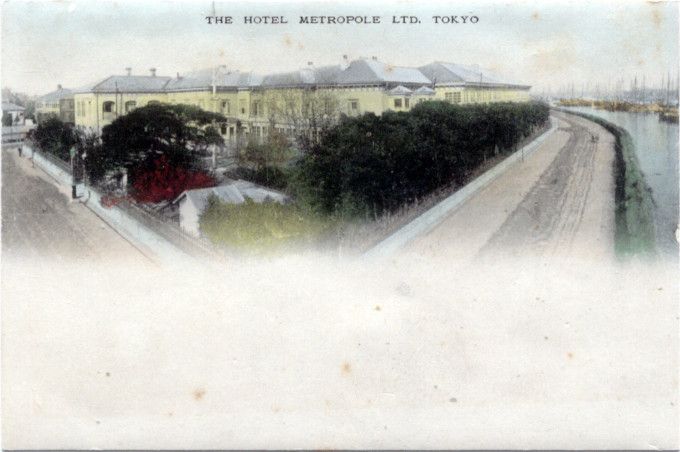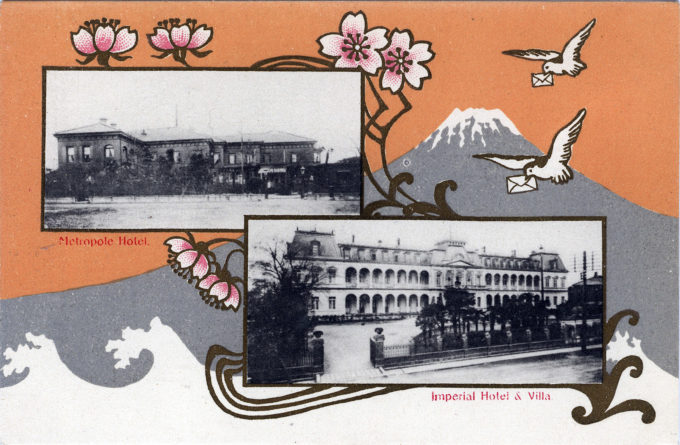
Hotel Metropole, Tsukiji, c. 1905. First used as the American Legation during the years when Tokyo’s foreign presence was restricted to the Foreign Settlement at Tsukiji, the building was repurposed into the Hotel Metropole after the conclusion of extraterritoriality. Hotel Metropole, the Imperial Hotel, and the Tsukiji Seiyoken Hotel represented Tokyo’s top-three première classe lodgings during the latter years of the Meiji Era.
“Those were the days of course of extra-territoriality and Consular jurisdiction, when the foreigner could reside only in sections specially designated. The quarter of Tokyo given over to foreign residence is known as Tsukiji. The word means ‘made ground’, the few acres having been made by filling in a part of Tokyo Bay … It is a low flat region but little above the line of high tide and a storm occasionally floods it.
“Here in a big wooden structure, which is now the Hotel Metropole, the first American Legation was established. The building overlooks the mouth of the Sumida river, the great water picnic ground of the capital whose turbid stream laps the edge of the hotel gardens and whose wide reach jostles with strange craft: fishing, sampan, little coasting tugs, whalers and sealers from the north, and mysterious queer-shaped vessels that form perhaps the only link between the modernity of present-day Tokyo and the still isolated villages of the coast of Japan and her many island possessions.
“Now only two of the smaller legations still cling to Tsukiji, the rest have moved a mile away to the higher, more ambitious quarter that holds the Imperial Palace and the Parliament buildings.”
– “The American Embassy in Tokyo”, The Overland Monthly, by C.E. Ferguson, February, 1910

Metropole Hotel and Imperial Hotel, Tokyo, c. 1905. Hotel Metropole opened in 1890 in the Foreign Settlement at Tsukiji as a branch of the Yokohama Club Hotel. In 1907, the hotel was purchased by the nearby Imperial Hotel for use as an annex of that illustrious hotel until closed in December 1910. Between 1911-1918, it served as the residence of Yamato Shimbun publisher, Matsushita Gunji. After the building was demolished in 1918, the former hotel grounds were then used as the site of St. Luke’s International Hospital, which remains today.
“The proprietors of the Imperial Hotel and the Hotel Metropole held a meeting on the 20th instant, and decided to amalgamate the two institutions with a working capital of 600,000 yen, namely 400,000 for the Imperial and 200,00 for the Metropole.
“The new arrangement will go into operation from the 1st of January next, when the Metropole will become branch of the Imperial.”
– The Japan Daily Mail, November 24, 1906


Pingback: Tsukiji Foreign Settlement, c. 1900. | Old Tokyo
Pingback: Imperial Hotel (1890-1922). | Old Tokyo
Pingback: Roseta hoter [sic], Tokyo, c. 1910. | Old TokyoOld Tokyo